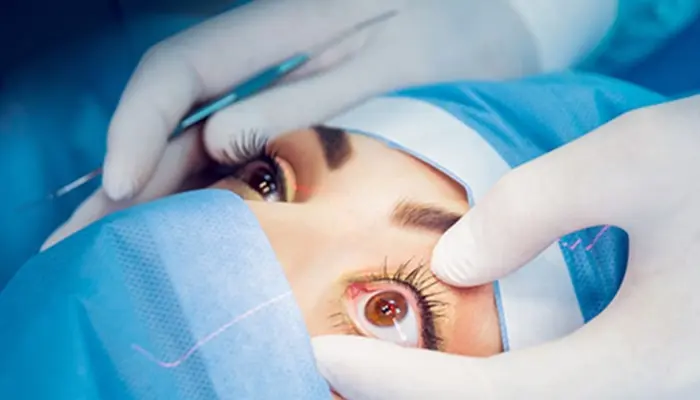Laser eye surgery, a popular solution for vision correction, promises a clearer, glasses-free future for many. Understanding the recovery process is crucial for anyone considering this procedure. This article will delve into the recovery timeline, factors affecting it, and tips for a smooth recovery.
Types of Laser Eye Surgery
LASIK (Laser-Assisted In Situ Keratomileusis)
LASIK is the most common type of laser eye surgery. It involves creating a thin flap in the cornea, reshaping the underlying tissue with a laser, and then repositioning the flap.
PRK (Photorefractive Keratectomy)
PRK involves removing the cornea’s outer layer and reshaping the underlying tissue. The outer layer regenerates over time.
LASEK (Laser Epithelial Keratomileusis)
LASEK is similar to PRK but involves preserving the outer layer of the cornea, which is then replaced after reshaping the underlying tissue.
SMILE (Small Incision Lenticule Extraction)
SMILE involves creating a small incision and removing a lenticule from the cornea to correct vision.
Immediate Post-Surgery Recovery
The First 24 Hours
In the first 24 hours after laser eye surgery, patients may experience discomfort, blurred vision, and light sensitivity. It’s crucial to rest and avoid straining the eyes. Most patients can resume normal activities within a day, but vision may fluctuate.
The First Week
During the first week, vision gradually improves. It’s essential to avoid strenuous activities and protect the eyes from irritants. Follow-up appointments are critical to monitor healing.
The First Month
By the end of the first month, most patients experience significant visual improvement. However, some may still experience halos or glare, especially at night. Regular follow-up visits ensure proper healing and address any concerns.
See Also: What Is The Success Rate Of Laser Eye Surgery?
Factors Affecting Recovery Time
Type of Surgery
The type of laser eye surgery significantly impacts recovery time. LASIK typically has a shorter recovery period than PRK or LASEK.
Age and Health
Younger patients with no underlying health conditions generally recover faster. Pre-existing conditions like dry eye syndrome can prolong recovery.
Adherence to Post-Operative Care
Strictly following post-operative care instructions, including using prescribed eye drops and avoiding rubbing the eyes, accelerates recovery.
Detailed Recovery Timeline for Different Surgeries
LASIK Recovery
Day 1
Immediate improvement in vision, but some blurriness and discomfort.
Avoid driving and strenuous activities.
Week 1
Vision stabilizes, but fluctuations are normal.
Follow-up visit with the surgeon.
Month 1
Most patients achieve optimal vision.
Mild dry eyes and light sensitivity may persist.
PRK and LASEK Recovery
Day 1
Vision is significantly blurred.
Discomfort and light sensitivity are common.
Week 1
Vision gradually improves but remains blurry.
The outer corneal layer regenerates.
Month 1
Significant improvement in vision.
Night vision disturbances like halos or glare may persist.
SMILE Recovery
Day 1
Quick improvement in vision.
Minimal discomfort compared to LASIK and PRK.
Week 1
Vision stabilizes rapidly.
Follow-up visit to ensure proper healing.
Month 1
Most patients achieve optimal vision.
Night vision disturbances are less common.
Managing Side Effects and Complications
Common Side Effects
Dry Eyes: Use prescribed lubricating drops to alleviate dryness.
Halos and Glare: Usually temporary, improving within a few weeks to months.
Fluctuating Vision: Normal in the initial weeks, stabilizes over time.
Potential Complications
Infection: Rare, but requires immediate medical attention.
Corneal Haze: More common in PRK, typically resolves with time.
Regression: Slight decrease in vision correction over time.
Tips for a Smooth Recovery
Follow Post-Operative Instructions
Adhering to the surgeon’s instructions, including medication use and activity restrictions, is crucial.
Attend Follow-Up Appointments
Regular check-ups help monitor healing and address any issues promptly.
Protect Your Eyes
Avoid rubbing your eyes.
Wear protective eyewear, especially during sports or outdoor activities.
Use sunglasses to shield your eyes from bright light.
Maintain Good Eye Hygiene
Wash your hands before touching your eyes.
Avoid makeup or creams around the eyes for at least a week.
Stay Hydrated
Drinking plenty of water helps maintain tear production and overall eye health.
Long-Term Vision Care
Annual Eye Exams
Even after successful laser eye surgery, regular eye exams are essential to monitor overall eye health.
Managing Lifestyle
Adopt a lifestyle that promotes eye health, including a balanced diet rich in vitamins A, C, and E, and regular exercise.
Understanding Vision Changes
Acknowledge that vision changes can occur with age, and additional corrective procedures might be necessary in the future.
Conclusion
Recovery from laser eye surgery varies based on the type of surgery and individual factors. By understanding the recovery process and adhering to post-operative care instructions, patients can enjoy the benefits of improved vision with minimal complications. Regular follow-ups and maintaining good eye health practices are key to long-term success.
In conclusion, laser eye surgery offers a promising path to clear vision, but a successful outcome depends on careful adherence to recovery guidelines and proactive eye care. Whether you opt for LASIK, PRK, LASEK, or SMILE, understanding the recovery timeline and managing expectations will ensure a smooth transition to a glasses-free life.
Related topics:

